Link Page Gunwriters Suomi
History, part 1/2

Suomi Submachine Gun, KP/-31
Part 2/2
Text: P. T. Kekkonen,
Photographs: J. Hartikka
Proofreading: Eero Juhola (See home pages: Finnish Weapons)
Magazines and Clips
The first KP/-31 magazine was a box or "clip" for twenty rounds. It is possible
to squeeze as many as 25 cartridges into this magazine which many sources mention as a
"twenty-five rounds box clip". Too many cartridges, however, resulted in first
shot feed jams and a weakening of the magazine spring. If a partially filled magazine was
dropped on a hard surface from waist-height some cartridges could compress the weakened
spring and turn around, bulleted end backwards. The manufacture of 20-round clips was
discontinued during the Winter War. Before production ended one improvement was made on
the construction by making the clip wider. Cartridges were staggered to two rows more
tightly so that it was possible to make the improved magazine about 20 millimetres shorter
compared with the "one and half row" clip. The capacity of this magazine,
however, was already considered to be too small.
The Early Drum
The designer Aimo J. Lahti was presumably the father of the 40 rd. drum magazine, known by
the nickname "sissilipas"( "ranger magazine") because of its small
size (the diameter was 145 mm) compared with the 70 rd. drum Model Koskinen. The
sissilipas is like a 40 rd. box magazine bent to circular shape and fastened onto the
bottom cover of the drum. A helical flat spring (similar to the main spring of a clock or
a phonograph) which tends to rotate a winged feed-plate is attached around the center of
the drum. A feed paw, projecting from the rim of the feed-plate into the cartridge groove,
pushes the staggered row of cartridges counter-clockwise towards the feed lips of
magazine.
Filling the drum is a somewhat tricky task, although no special tools are required. It is
advisable to fill the drum to full capacity by first removing the cover and winding the
feed-plate clockwise until it snaps and is held fast. Placing 40 cartridges into the feed
groove is not too easy because they must stand bullet downwards. It is recommended to
prevent the row of cartridges from toppling with a finger-tip or a wooden stick. When the
groove is full and the cover of the drum replaced, the last step is to release the feeder
by closing the sliding bar of the cover. The feeder then pushes the row of cartridges with
the full power of the spring.
A true "vanity of vanities" is a little round aperture or a "magazine
window", stamped through the bottom of the magazine and the numerals 1 to 40 stamped
on the feed plate. In theory it was possible to check the number of remaining cartridges
from the window. In practice the stamped figures were very difficult to see even in
daylight, and dust or dirt had entrance through the window to jam delicate parts of the
magazine. Excessive lubrication made things still worse. A seventy round magazine was
planned to be developed using a staggered-row feed groove principle, but the 70 rd. drum
m/Koskinen was found to be superior in reliability and cost-efficiency.
Aimo J. Lahti also designed a sixty round drum with "windmill wings" or
sprocket-wheel feeder; it was more or less a copy of Thompson's L- or C-drums. It was easy
to fill because the rows of cartridges were divided into compartments; they could not fall
down like Domino pieces. It is still unknown why this model was never adopted for
production. (The idea of a Thompson-type drum came back in 1943 when A. J. Lahti made
prototypes of his AL-43 assault rifles. Industrial capacity in Finland was unfortunately
insufficient for the manufacture of entirely new-fangled firearms. The drum of AL-43 held
56 cartridges).
Drum m/Koskinen
The co-designer of the KP/-31 lieutenant Y. Koskinen continued his independent work after
the dissolution of Konepistooli Oy. He did no more firearm designs but concentrated
instead on other equipment related to them. The Finnish 70 rd. drum for KP/-31 was his
innovation, and it proved to be the most succesful magazine of the Suomi submachine gun,
both before and during World War II and until the mid-Fifties.

Ltn Koskinen introduced his magazine in 1935. On January 28, 1936 Tikkakoski Oy received
an order from the Finnish Army Ordnance Department for 8000 drums m/Koskinen. Follow-up
orders were for 20 000 drums in April 1936 and for 21 000 magazines in January 1937. A
sufficient quantity for the four thousand KP/-31 used during the Winter War, and one
answer to question "How come Finland could stand while Poland, the Baltic republics
and France all fell in some weeks, days or hours ?" Men behind guns and guns in the
hands of men did their duty..!
Winding the 70 rd. drum's mainspring. This is usually done before the laying of cartridges.
The 70 rd. drum was, if a somewhat overly simplified description is allowed, a
combination of two 40 rd. magazines mounted together in concentric fashion. There are, of
course, some refinements over the original construction. The cartridge rows are no longer
staggered and the cover or lid of the 70 rd. drum is on the front face of the magazine.
When filling the feed grooves it is now possible to place the cartridges standing on their
flat ends, thus preventing the "Domino pieces" from toppling with less effort.
The 70 rd. drum has a "phonograph mainspring" like the 40 rd. sissilipas, but it
is possible to wind it for almost two complete rotations clockwise. Each rotation is
divided to four "clicks" of the ratchet. Partial filling of the drum, if
necessary, is therefore easy to do and thus the feed spring is protected from weakening. A
feed-paw, actuated by spring capsule (similar to one from a "His Master's Voice"
phonograph), pushes the inner cartridge groove empty from cartridges.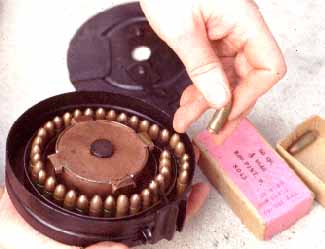
A filled seventy rounds drum "M/Koskinen" after winding the mainspring (two full rotations, eight clicks of the ratchet). The inner and outer feet grooves hold 35 rounds each.
If more than 35 cartridges are loaded into the magazine these are placed in the outer
feed groove. The inner groove is fastened on a rotating feed-plate. A steel clip,
projecting outward from the plate, pushes cartridges from the outer groove to the lips of
magazine and stops the rotation of the feed-plate when the outer groove is empty. The
remaining 35 cartridges now start to flow into gun through the feeding lips.
Imitation is the highest form of flattery: The Russians showed their respect of ltn
Koskinen by adopting a detailed copy of his remarkable innovation during the Winter War
and the Russian Great Patriotic War. Millions and millions of 70 rd. drums were made in
Soviet Russia and later in Red China and European Communist Block countries for copies of
the Pulemyot Pistolyet Shpagina model 1941 submachine gun. Not too many users of
these guns knew that the origin of the magazine in their tool of destruction was Finnish,
not Russian.
The Fifty Rounds Box Magazine
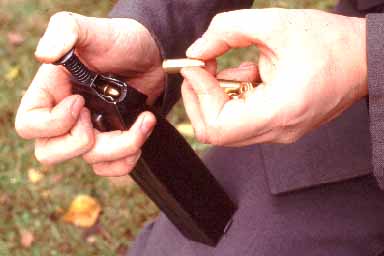
Loading the 50 rd. box magazine, known as
"ruumisarkku"; the coffin. A loading tool is essential to push in the
recommended 40 to 45 cartridges. With the tip of a screwdriver it is possible to squeeze
some thirty rounds into the "coffin", and with bare fingers presumably no more
than ten cartridges.
Sweden adopted a shortened variation of the KP/-31 for manufacture under licence as the
Kulspruta or Maskinpistol Model 37-39 and bought full-size guns from Finland as the model
37-39 F. The Swedes were not satisfied with the 70 rd. drum, finding it overly
complicated, expensive and too heavy compared to its cartridge capacity. Apparently the
Swedish firm Linde AB designed a novel, four-row 50 rd. box magazine that was 40 per cent
lighter in "dead weight" compared to the 70 rd. drum m/Koskinen.
The Swedish magazine is composed of two staggered-row box magazines with a common feed
"throat" tapering to feed lips, similar to all earlier magazines of KP/-31: The
distance between the lips is considerably less than diameter of a cartridge case. Filling
the magazine is therefore slow and tedious, even with a special filler tool (any user of
the STEN gun will probably concur with this statement)
The magazine followers of the Swedish 50 rd. "coffin magazine" are of cast
aluminium alloy, presumably too soft a material for the purpose because the feed springs
are truly heavy. The springs are tapered and it is possible to compress them down to a
very small space thus keeping the overall length of the magazine not much longer than that
of the 20 rd. box clip. The Finns were fascinated by the light weight and inexpensive
manufacture of this magazine.
250 Swedish magazines were bought before the Winter War for tests by military units. In
1940 Tikkakoski Oy bought the manufacturing licence for the "coffin magazine",
but feed springs for them were bought from Sweden until the end of production. 120 000
Swedish pattern 50 rd. magazines were made by Tikkakoski Oy in the years 1941 to 1943. By
then the many drawbacks of mechanism had became well-known: the magazine is impossible to
fill with much more than ten cartridges without a special tool. This in itself was not a
rare defect but battlefield experience had revealed some other drawbacks as well.
The balance of the feed springs was critical and the Swedish springs were sometimes of
varying quality. It was possible to wrongly re-assemble the magazine after
field-stripping. Feed jams were met frequently if the magazine was filled up to full 50
rd. capacity. A reasonable quantity of cartridges is 40 to 45 rounds (this author has shot
ca. 3000 rounds using "coffin magazines" usually filled with 25 and never more
than 30 cartridges. No feed jams or other disorders were apparent. This author has, of
course, filed and honed away all the sharp burrs from the feed lips).
The magazine was also too frail to stand knocks or battering. A slight bruise or a small
quantity of dust or dirt inside a loaded magazine could render it unserviceable. The
manufacture of the Swedish pattern 50 rd. magazines was terminated in 1943, when the
technical superiority of the Finnish 70 rd. drum had - once again - been demonstrated.
36 Rounds Box Magazine
After the Second World War there were more than sixty thousand of KP/-31 delivered to
Finnish armed forces, along with 10 000 submachine guns m/-44 (Finnish copies of the
Russian Pulemyot Pistolyet Sudayeva m/-43). Magazines, including drums, were the same for
both models. Huge quantities of magazines were worn out or lost during the war. For
example Finnish ranger patrolmen classified the 40 rd. drums as "disposable
magazines" or "throw-away drums ". Empty drums were actually thrown away
because they were almost impossible to refill during battle. In the first years of the
Fifties there were only two or three magazines for each gun.
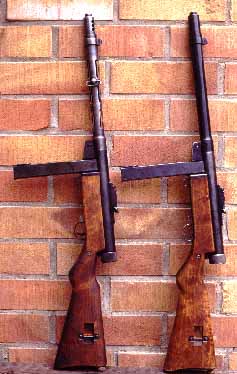 A Suomi KP/-31 SJR and
another specimen with a Barrel Unit SS-II. Just a lack of perforations in the jacket and
compensator may reveal the difference... until actual shooting! The magazines are
Lapua-made 36 rd. boxes "M/55".
A Suomi KP/-31 SJR and
another specimen with a Barrel Unit SS-II. Just a lack of perforations in the jacket and
compensator may reveal the difference... until actual shooting! The magazines are
Lapua-made 36 rd. boxes "M/55".
The formerly German-owned Tikkakoski Oy was occupied by Russians and made only sewing
machines and vacuum cleaners. The know-how and machinery for manufacturing of drum
magazines was under the control of the Arch Enemy. It became necessary to adopt an
entirely novel type of magazine.
The famous Swedish Carl Gustaf Model 1945 submachine gun had a box magazine "m/45
B", capacity 36 rounds, with mounting rails similar to those of the
50 rd. "coffin magazine". A new and interesting feature was the wide
"mouth", which enabled easy filling of the magazine by pushing cartridges down,
sideways. No special loading tools are necessary. The pressure of the feed spring was just
reasonable - no longer excessive. The strength of one's fingers was
usually sufficient to fill the magazine with 30 to 35 cartridges without undue effort. The
length of the magazine "m/45 B" is 225 millimetres and the width 25 mm.
The magazine was found to be as durable and reliable as the 70 rd. drum but much less
expensive to manufacture. The first Finnish copies were made by Ammus Oy in 1954. The run
of batch was, fortunately, only a hundred magazines; They were made carelessly and without
all the necessary know-how. Swedish-made sample magazines, bought for the sake of
comparison, were found to be of good quality and their price was much lower due to steady
mass production.
The Swedish manufacturer AB Linde Kvarnmaskiner offered their magazines. They were
officially adopted for use by the Finnish Army on December 21, 1954 as magazine
"m/54", and AB Linde received an order for 50 000 magazines from Finland one
week later. This quantity was but one fifth of the needed quarter of a million 36 rd.
magazines. The Lapua Cartridge Factory now offered to manufacture 200 000 magazines
similar to the model m/54, at a competitive price. The General Staff of the Finnish
Army placed an order on March 5, 1955.
The Lapua-made 36 rd. box magazine is the "model/55". Technically it is similar
to Swedish "m/54", with the addition of a steel-wire carrying loop. The quality
of the Finnish-made magazines "m/55", kept in depots for emergencies, is
excellent and they are usually sold to collectors in auctions or from Army surplus shops
in mint condition. Conscripts trained as submachine gunners during the Sixties and early
Seventies (including this author) received two battered 70 rd. drum magazines along with
their government issue KP/-31. In 1967 there were 65 rounds of bulleted cartridges issued
for the training of each submachine gunner during seven months' military service. The
magazine well of almost every KP/-31 was widened for the "m/55" magazine before
the early Seventies as a part of routine maintenance.
Variations and Special Models
Receiver, breech-bolt and trigger mechanism are unchanged in all variations of KP/-31,
save rare prototypes made for intended Persian export. These had top-mounted box magazine,
without option for use of drum magazines. Bipod was usual outfit. "Persian
model" was called as KP/-33. (Persia is nowadays known as Iran). At
least one variation of KP/-33 was furnished with a pistol-grip and quickly-detatchable
wooden butt, like Thompson submachine gun.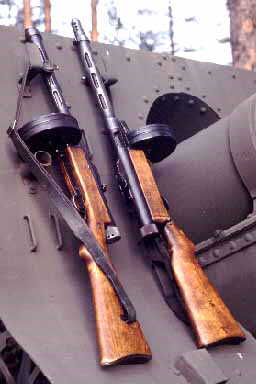
The receiver, breech-bolt and trigger mechanism are unchanged in all variations of KP/-31
save some rare prototypes made for intended Persian export. These had a top-mounted box
magazine and no option to use drum magazines. A bipod was usually fitted. The
"Persian model" was designated the KP/-33 (Persia is nowadays known as Iran). At
least one variation of the KP/-33 was furnished with a pistol grip and a
quickly-detatchable wooden butt, like that of the Thompson submachine gun.Some guns model
KP/-31 were also equipped with a bipod and a pistol grip, mounted between the
trigger-guard and the magazine well. These gimmicks were soon found to be unnecessary.
KP/-31 (left) and KP/-31 SJR (right):
The main variation since 1942 is KP/-31 SJR (from the word "suujarru" -
muzzle brake or compensator). The designer A. J. Lahti did not like the compensator
because the oblique front end of the barrel jacket was found to be as efficient a reducer
of muzzle climb as any adaptation of the "Cutts Compensator". The muzzle
pressure of a submachine gun is actually too low for any noteworthy compensating effect.
The muzzle brake of the KP/-31 SJR was troublesome in frosty weather. Solid powder and
primer residue could become trapped in the chamber of the projecting compensator and
reflux thru the bore into the receiver. The sticky mass of condensed
water, carbon and salts could literally paste onto the snugly fitting breech-bolt, causing
misfires and accidental firing.
Misfire outdoors in the cold could release the breech-bolt from the grip of the sear and,
if the gun was then warmed, when a loaded magazine was mounted, it might
suddenly fire when the residue holding the breech-bolt thawed. It was not just advisable
but strictly mandatory to remove the magazine from a "frozen" submachine gun
before any attempt to melt the breech-bolt loose by warming or shooting a cartridge,
loaded manually into the chamber, was made. As soon as possible it was essential to
field-strip the gun and clean its receiver, breech-bolt and compensator.
The enraged A. J. Lahti attempted to find out who the inventor of the compensator was and
to have him charged in a military court, but to this day the identity of the
"genius" responsible remains strictly classified. Despite these well-known risks
the Finnish Army ordered all new Suomi guns with the SJR device beginning in 1942. On the
other hand the Civil Guard demanded normal short jackets for guns ordered for their
members until 1944 when the Russians forced the government of Finland to suppress the
Civil Guard.
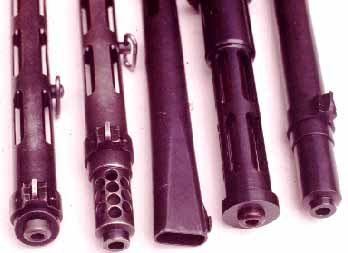 Muzzles of KP/-31, KP/-31
SJR (with compensator), "Korsu-Suomi" (with flattened "vacuum cleaner
nozzle"), "Tank-Suomi" and Barrel Unit SS-II, silenced variation model
1995.
Muzzles of KP/-31, KP/-31
SJR (with compensator), "Korsu-Suomi" (with flattened "vacuum cleaner
nozzle"), "Tank-Suomi" and Barrel Unit SS-II, silenced variation model
1995.
The phrase "any Guardian is a better authority on firearms than all Finnish Army
generals" was not just an idle boast. Some sources have called the KP/-31 SJR the
"model -31/-42". This designation is incorrect and misleading because there was
an independent "model 1942". Just a few prototypes of the KP/-42 were made.
Despite the many improvements upon KP/-31 it was impossible to adopt a new model during
the war. (There are no rules without exceptions: The KP/-44 or "sheet-steel
submachine gun", also known as the "Tin Henry", a
short-cut from expensive first generation gun to cheap third generation gun).
The improvements of the KP/-42 were: Less expensive fastening of the wooden stock by a
Martini-Henry screw; less expensive but more durable sights; a front sight with protecting
"ears" and a firing-mode selector returned to the right side of the gun.
The "Korsu-Suomi"
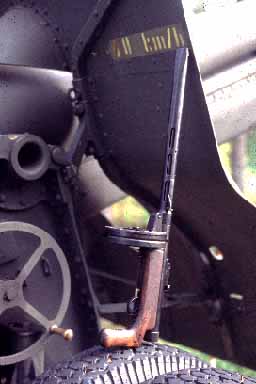 This Bunker Suomi or pill-box gun is a highly
specialized weapon for shooting through the narrow, horizontal firing slits of
hemispherical steel bunkers, the so-called "Mannerheim's helmets", and concrete
bunkers built along the so-called Mannerheim Line.
This Bunker Suomi or pill-box gun is a highly
specialized weapon for shooting through the narrow, horizontal firing slits of
hemispherical steel bunkers, the so-called "Mannerheim's helmets", and concrete
bunkers built along the so-called Mannerheim Line.
The "Korsu-Suomi" Bunker Gun is almost as long as the normal KP/-31 with a butt stock because of an extra-long barrel jacket, necessary to funnel powder gases out from the bunker. The barrel length of all Finnish-made versions of KP/-31 is 314 mm, the only exception being the new Barrel Unit SS-II.
Shooting with a normal KP/-31 thru a ca. one inch high firing slit was difficult - if
not impossible - and even unhealthy. It was impossible to use sights and powder gases
threatened the gunner with nitrogen oxide or carbon monoxide poisoning. The shoulder stock
of the KP/-31 was also an inconvenient and useless component for a bunker gun.
The design of the Bunker Gun was begun in August 1939. Before the Winter War there were
two lengths of "duck-bill" barrel jackets with fixed, side-mounted sights and a
welded frame for a pistol grip . Experience indicated the longer jacket (435 mm) was
better than the shorter one (385 mm) for eliminating muzzle flash and evacuating powder
gasses from the bore before opening the breech-bolt between shots.
Before Finland's Third Independence War the construction of the pistol grip was simplified
so that it was possible to mount either a normal stock with shoulder butt or a pistol grip
with a forked tang to receiver of gun. The first phase of the 1941-1944 war was, however,
a Finnish invasion of the most favorable positions for defence against Russia. 500 jackets
of the Bunker Suomi were mounted on receivers with full-length stocks. Although there were
no front sights above these jackets the submachine gunners could soon master their guns
without any use of sights at all, just like well-trained skeet-shotgunners.
The "Tank Suomi"
This model is not an entire gun but a combination of a firing port jacket and
pistol-butted KP/-31s. The jackets were mounted on Finnish tanks, of the Christie or
Vickers type, and the Bunker Gun was mounted in that jacket just before driving towards
the battlefield. If the tank crew was forced to fight dismounted, after the destruction or
a less permanent immobilization of their armoured vehicle, it was possible to leave the
barrel jacket into firing port of the tank or armored car and to fix a normal KP/-31
jacket to the gun.
The "Tank Suomi" is among the most rare variations of the KP/-31. Only 31
jackets, serial numbered along with pistol-grip submachine guns, were assembled in July
1940. No further submachine guns with firing port jackets were needed because the Russians
brought the Finnish tank corps a more than sufficient quantity of Degtaryeva Tankovoy
machine guns during the Winter War. These 450 DT tank machine guns (of caliber 7.62 x 54
mm Russian) easily displaced Tank Suomi guns. There were more than six Tankovoy machine
guns for every Finnish armored vehicle. Surplus DTs were issued to infantry units,
equipped with bipod and sights. Our photograph shows the presumably only privately owned
Tank Suomi submachine gun jacket.
"Ancient? Obsolete?"
Finnish Army conscripts look at the Suomi submachine gun KP/-31 with the same curiosity as
they would a steam locomotive or a gramophone in a technical museum. The assault rifle is
today the general-purpose instrument of the Finnish armed forces. An unknown quantity of
submachine guns is still stowed up in depots but many of them are being sold to
collectors. Spare parts and unfinished forgings have also been made available. The KP/-31
was found to be "ancient" in 1944 but obsolete it has become only in the
Nineties.
As a fighting instrument in forested terrain the KP/-31 is still fully serviceable because
the engagement distance is usually less than a hundred meters. However modern
doctrine favors a one caliber system of ammunition as far as is possible. The assault
rifle is able to do the duty of a submachine gun. So why carry two kinds of individual
firearms with different cartridges?
The Last Model
The availability of unperforated, semi-finished forgings of barrel jackets made possible
the creation of some prototypes of the Barrel Unit "Model SS". The abbreviation
comes from "Suhina-Suomi" (Sighing Suomi). The
barrel of the SS-II Unit is shortened and drilled through walls like the barrels of the
STEN Mk II S or the Welrod Hand Firing Device, to lower the pressure of powder gas in the
bore and to slow down the bullet velocity below Mach 1, the speed of sound. The barrel
jacket of the SS-II Unit forms the outer casing of the integral sound suppressor a.k.a.
silencer.
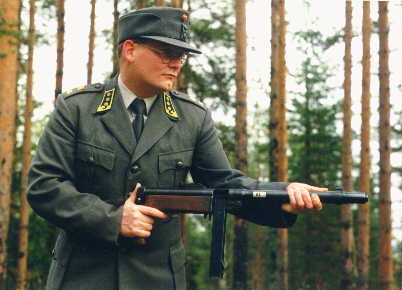 The "Suhina-Suomi
II" suppressed barrel unit mounted to a "Korsu-Suomi".
The "Suhina-Suomi
II" suppressed barrel unit mounted to a "Korsu-Suomi".
The unit is of a telescopic construction. Twenty cupped baffles, similar to those of
famous Maxim Silencer, are stacked into the front end of inner suppressor sleeve. This
sleeve is fastened by a threaded cap into the jacket and is removable as one part.
The barrel is centered into the sleeve by a perforated support and a solid septum. A
snugly fitting shoulder in front of the barrel flange centers it into the jacket. Powder
gas, bled from barrel perforations, fills the space between the sealing shoulder and the
septum known as the "blowback intensifier chamber". The bullet, emerging from
the muzzle, flies through the stack of baffles. The muzzle blast hits the conical
diffractor and the curved reflector, refluxing to an expansion chamber around the barrel.
When the bullet emerges from the mouth of the suppressor, powder gas is trapped in the
expansion chamber and into the spaces between the baffles. This part of the gas flows
slowly out of the suppressor mouth with a muffled "sigh". Another volume of gas,
trapped into the blowback intensifier chamber, escapes into the bore through barrel
perforations. The rapid reflux of the gas accelerates the rearwards movement of the
breech-bolt.
The component parts of the Barrel Unit are enclosed in the jacket which may be mounted
onto any KP/-31. The use of a slightly shortened recoil spring may be necessary in order
to avoid uncontrolled fire when shooting the least powerful factory-loaded cartridges or
subsonic handloads made for guns with a traditional muzzle-can suppressor. The mechanical
noise of a suppressed KP/-31 is conscipiously low due to the heavy steel construction of
the receiver and the noise-absorbing, wooden stock.

Drawing of "Sunina-Suomi" SS-II Silenced Barrel Unit. Special variations of SUOMI KP/-31 are still topical items.
The original " Barrel Unit SS" was designed in the early Nineties by Mr. Juha
Hartikka of BR-Tuote, Joensuu, Finland (a famous
manufacturer of suppressors and other equipment related to firearms). A drawing of an
improved Unit SS-II is dated September 15, 1995, five years after the design of the
original B.U.S.S.-I. Although the Suomi KP/-31 has officially been declared
"ancient" and "obsolete", if not yet a "curio", its
development seems to be continuing.
Old soldiers never die and firearms designed to be "everlasting" do not fade
away easily.
* * * * * * * *
On the History of Finland and Submachine Guns
The name "Suomi konepistooli" has been found in some official
documents of 1925 as a code name (like "Parabellum" was the nickname of the
Borchardt & Luger/DWM pistol from about 1899 or 1900 onwards). The word
"Suomi" means "Finland" (the name of the country) in Finnish. The word
"osakeyhtiö", abbreviated "Oy" or "o/y". means
"limited company" or "Pty. Ltd". Limited company is
"aktiebolag", abbreviation "AB" in Swedish. Many Finnish companies use
both Finnish and Swedish abbreviations in their names, e.g. Oy Tikkakoski AB, because both
of these languages are officially used in Finland.
The First Independence War of Finland was a civil war between patriotic Finnish people and
Bolsheviks, the so-called Red Guard. Both sides were aided by Russians. Russian Bolsheviks
donated armament to the Reds and general Carl Gustav Emil Mannerheim, the leader of the
victorious Civil Guard or White Peasant Army, was also an officer of the Imperial Russian
Army before the October Revolution of 1917.
The Independence War broke out on January 23, 1918 and the Bolshevik Mutiny on January 27.
The White Army and auxiliary troops from the Imperial German Baltic Sea Division liberated
southern Finland in a couple of weeks before a never-to-be-forgotten triumph parade in
Helsinki on May 16, 1918.
It was the first time when a heroic Finnish people stopped the Great Red World Revolution
but it would not be the last one. Vengeful Russian Communists, along
with Finnish Bolshevik refugees residing in Soviet Russia, tried to conquer Finland in two
weeks starting on November 30, 1939.
Finland stood alone but our people were able to stand and struggle until March 13, 1940.
This war is known as the Winter War or 105 Days of Glory in Finland, but as a Disgraceful
War in Russia since 1988. (In the earlier Soviet Union's history writing this campaign was
almost entirely forgotten). Both Finns and Russians knew that the armistice after the
Winter War was nothing but a frail truce.
Some days after the start of the German "Operation Barbarossa" the Russians
begun air-raids against more than twenty densely populated communities in Finland. In late
June 1941 it was realized that a state of war existed between Soviet Russia and Finland.
As an ally of Germany Finland was able to conquer the territories lost to Russians after
the Winter War and push still forwards to more favorable defensive positions.
This Third Finnish Independence Struggle became a kind of trench warfare by the late 1941
or early 1942. On June 10, 1944 when the Germans were obviously already losing the Second
World War the Russians were able start a massive attack on Finnish troops. The retreat of
the Finnish armed forces ended in July or early August 1944. The Russians were suffering
huge losses of military forces, ordnance and transport, including armored vehicles, due to
Finnish defensive actions. The wave of Worldwide Red Revolution was once again broken on
the rock of the determined Finnish people, once again supported by the Germans - just as
during the last weeks of the First Independence War of 1918.
Third Independence War of Finland (so called by the then President Risto Ryti in 1941) is
usually known as the Continuation War, because it was an inevitable continuation of the
Winter War, which in itself was a continuation of the Independence War of 1918. This third
war against Red Russia ended on September 5, 1944 but the Second World War was not yet
over in northern Finland. The last phase of it was an "infamous war" against the
Germans retreating from that area of Finland.
The Finns were unwilling to harass their former comrades in arms but it was Red Russia
which dictated the rules of Finnish politics from September 1944 until August 1991, the
bitter end of that Reign of Wickedness. The shameful war in Finnish Lapland was over on
April 27, 1945, less than two weeks before the end of WWII.
There is no reliable evidence to confirm whether submachine guns were used in the 1918
war. The production of the Bergmann MP 18-I had just been started
in April 1918 and all guns were needed in the European trenches. The Winter War taught the
whole industrialized world to appreciate submachine guns. Sir Winston Churchill would
never again scorn the Thompson gun as a "tool of American gangsters, unfit for use by
honest Britons". In fact he begged from the U.S.A. as many Tommy Guns as the Auto
Ordnance Company could assemble.
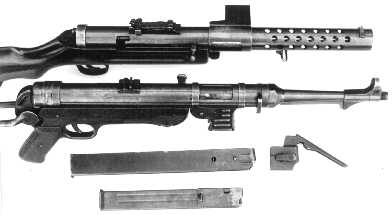 Adolf Hitler, a veteran of the First World War, knew
better than any other influential statesman the importance of submachine guns. He pressed
German designers to improve the existing MP 38 so that it would be more suitable for mass
production. The simplified MP 40 met these requirements.
Adolf Hitler, a veteran of the First World War, knew
better than any other influential statesman the importance of submachine guns. He pressed
German designers to improve the existing MP 38 so that it would be more suitable for mass
production. The simplified MP 40 met these requirements.
Bergmann MP28-II (above) and MP 40.
During the Winter War the Soviet Russians possessed just as many submachine guns as
their Finnish opponents; they had about 4000 guns of two or three different models. They
were made like expensive "de luxe" shotguns and were therefore unfit for use in
cold weather. So they were returned to arms depots.
In 1941 Georgiy Shpagin designed a very succesful second generation gun which was suitable
for inexpensive mass production and much more reliable in winter warfare than any other
contemporary submachine gun. Many Germans adopted PPSh -41 guns for their own use because
captured 7.62 x 25 mm cartridges were plentifully available from Killed In Action Russian
gunners or conquered ammunition depots.
The reliable functioning of the Pulemyot Pistolyet Shpagina fascinated the Germans,
especially when a freezing Russian winter halted the first phase of Operation Barbarossa.
Chilly weather also made supply lines difficult to travel. The supply of Russian ammo was
lot more plentiful and assured than the availability of 9 mm Luger cartridges for German
MPs.
The large capacity of the drum magazine was also found to be more useful than the 32 rds.
box clip of German submachine guns and the cyclic rate of fire was twice as high as that
of the MP 40. The PPSh -41 shot sixteen or seventeen bullets per second, while the MP 40
shot only seven or eight. The high cyclic rate was beneficial for mowing down large, dense
hordes, "human waves" of Russians.
The wooden butt of the PPSh -41 was also more comfortable to keep against the cheek than
the collapsible steel stock of the MP 38 or 40, especially in cold weather. The German
designer Hugo Schmeisser developed a hybrid model MP 41, with the action of the MP 40 but
a wooden buttstock of the earlier Bergmann MP 28-II.
A patent litigation brought about the discontinuation of the MP 41. The action of the MP
38 and MP 40 was designed by Heinrich Vollmer of ERMA GmbH, which was the plaintiff in the
case. The manufacturer of the MP 41 was Waffenfabrik C.G. Haenel of Suhl.
The Haenel firm was found guilty of patent infringement and obliged to cease the
production of the Maschinenpistole MP 1941 by the judgement of the Berliner Kammergericht
(= Chamber Court; a least authoritative court in Germany). A great triumph of
bureaucracy...! Heinrich Vollmer was undeniably the designer of MP models 38, 38/40 and MP
40 (usually called Schmeisser), but Hugo Schmeisser was the inventor of the submachine gun
with blowback action.
Some Finnish warriors also adopted captured PPSh -41 guns during the offensive phase of
the 1941 -44 war. 7.62 x 25 mm cartridges were plentily available from killed Russians and
captured ammo depots or baggage. When the cartridges ran out "Pepesha guns" were
simply thrown away or delivered to Army depots. Many warriors brought disassembled PPSh to
their homes as souvenirs but this practice soon became too risky. In early 1942 one daring
private attempted to bring home a disassembled Russian 50 mm mortar in his knapsack. He
was caught and after this unfortunate incident soldiers headed for home on leave found
their luggage more carefully examined by "lousy War Dogs" (Military Policemen).
Heaps of captured PPSh guns were stocked in depots. At one point there were plans to
modify them to use 9 mm Luger ammunition by replacing the barrel and shortening the space
between the "jaws" of the magazine well to that Finnish magazines could be used.
This modification was soon found to be too difficult to accomplish. The Russian 7.62 mm
Tokarev cartridge is five millimeters longer than the 9 mm Luger cartridge and Finnish
magazines were accordingly less high. It was possible to narrow the magazine jaws by
splitting the receiver into two parts, milling and welding the parts together again.
However the welding weakened precisely the least durable place of the receiver. (Nobody
realized that Russian magazines feed 9 x 19 mm cartridges without a hitch, despite the
cartridge's shorter length !)
Making 9 mm barrels also proved to be a troublesome task, not a simple re-drilling and
re-rifling process. The barrel had to be removed from the combined unit that was the
barrel, jacket and upper receiver. The hard-chromium plating of the bore was destructive
to drill bits. The enlargened bores too often became crooked and/or too large and rough.
Only a handful of PPSh guns had been equipped with Finnish-made 9 mm barrels by the time
the modification project was discontinued as impractical.
Despite the limited production capacity the numbers of the Suomi KP/-31 were increased to
meet the demands of Finnish armed forces. There are some similarities between the KP/-31
and PPSh -41 such as magazine capacity, cyclic rate of fire and the wooden buttstock. The
Finnish gun is, however, a first generation submachine gun while the PPSh is a typical
second generation submachine gun: Mass-produced for a massive army, and thus possessing
neither quickly detachable barrel nor some other luxuries such as versatility with very
slight - if any - alteration of the receiver mechanism.
Link Page Gunwriters Suomi History,
part 1/2
Gunwriters on the Web Suomi SMG History part 2 website URL: http://guns.connect.fi/gow/suomi2.html